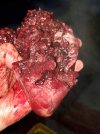I'm concerned about a detail that has been skipped in this thread. The writer says that the recovered weight was 97grains from a 100grain bullet. That means that the NOSE CLOSED UP. the petals did not expand or detach. It is exactly the kind of scenario that the Tipped Barnes are supposed to prevent. Could this have been a non-tipped TSX? For this post I will assume 'not', and assume a tipped TTSX.
If the bullet closed up, then it was not a blunt cylinder going through the animal, but a more "aerodynamic" slug. Such a slug is able to slip through material more easily and does not create the disruptive damage that a blunt cylinder will cause.
This brings us to the perfect storm of diameter. Smaller calibers are able to slip through some animals without doing fatal damage if they manage to pass through without disrupting medium to major blood vessels. Such ballistic trajectories are relatively rare, but they do happen with smaller calibers. That is why older guides and professionals have come up with certain standards on larger and dangerous game. A 30-caliber bullet will kill a Cape buffalo and many have. But enough of the smaller-caliber-on-buffalo apparently led to stories like the deer in this thread. Only be increasing diameter did the professionals begin to see a significant diminishing of animals escaping. Most African countries now require a .375" minimum, though some used to call for 0.4". Have I hunted and killed buffalo with less? Sure. The 338 is a great caliber. But diameter counts, and somewhere between .338" and .4" the "escape curve" turns downward.
Personally, I think that 25 caliber is too thin for a deer if the petals close up and dive through. Yes, in most cases it wouldn't matter, but there will be instances like in this thread. Penetration is probably factor number one after bullet placement, but wound channel follows as the next factor. What one needs is more of a guaranteed blunt cylinder (totally different from a rounded nose) smashing through or else more diameter if one wants to lower the 1% to 5% of irregular terminal results.
I have to agree. 3% of weight doesn't account for petals being shared off. It may just be the loss of the tip. If that's what happened, and the bullet never expanded but penciled through quickly, it explains the poor performance. I don't have the bullet in front of me so obviously I can't examine it as well as the OP, but I don't think it expanded.
It sounds like OP hit him more or less where he should of given the angle of shot he had. Maybe that wasn't an ideal angle, but it sounds like poor bullet performance led to a bad outcome in what should have been a quickly fatal shot.

